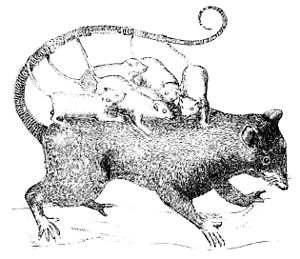often crawl away as soon as its enemy is gone. Its great endurance is also shown by the fact that when fat it can live for three or four weeks without food or water.
The female is very fond of her young, enjoying with them that domestic felicity portrayed by Florian in his happy table, "La Sarigue

Fig. 2.—Merian's Opossum (Didelphys Dorsigera) with Young.
et ses petits," and she will offer every resistance, and suffer greatly, to prevent any one looking into her pouch to examine her offspring.
In Europe, Asia, and Africa, not a single marsupial exists. Our only species, Didelphys Virginiana the opossum, is found from the Great Lakes to the Gulf, and from ocean to ocean; but it has several relatives in South America, where about twenty species exist, such as the sarigue, shupati, and carigueya, of Brazil. In some of these the pouch is rudimentary, affording little protection to the young, which hang fast to the nipples until able to jump about, and then are carried on the back of the female, where they cling to her wool and gain additional support by coiling their tails around hers. Perhaps the most cunning of this sort is the so-called Merian's oppossum (Didelphys dorsigera), of Surinam, represented in Fig. 2. Also, the yopock (Cheironectes palmatus) is peculiarly interesting on account of its aquatic habits and webbed feet, adapted to swimming. Its foot also has a long-tubercle, which has been mistaken for a sixth toe, and the mouth is furnished with large cheek-pouches. It inhabits holes along the streams of Brazil, and lives on small aquatic animals, spawn of fish, etc. Its mode of life reminds one of the ornithorhynchus and the otter. A specimen of this species was caught alive near Pará, in a fish-trap similar to the kind of basket with a funnel-shaped opening used for catching eels. Although marsupial animals are so exceed-
